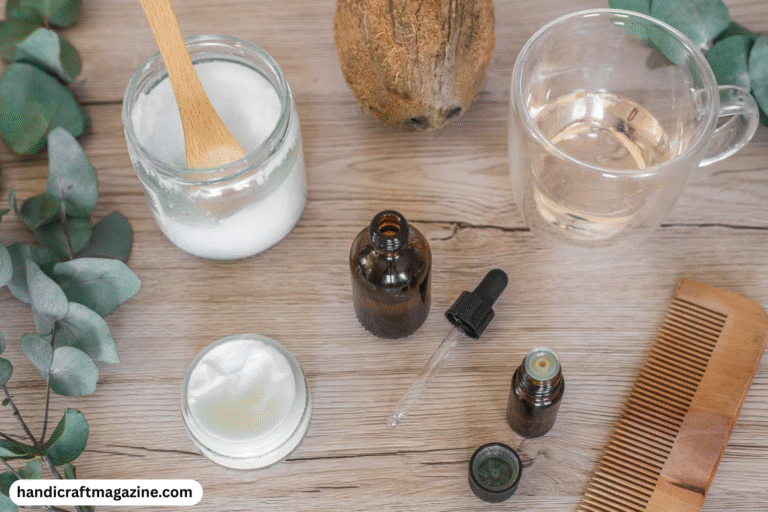Introduction
Learning how to make shampoo at home is a rewarding and practical skill. It gives you full control over the ingredients, making your hair care routine safer and more personalized. For anyone sensitive to chemicals or simply curious about crafting natural solutions, homemade shampoo offers an excellent option.
This article will guide you through the basic process of how to make shampoo, explain how to tailor ingredients to your hair type, and show how to enhance its fragrance and effectiveness. By the end, This step-by-step DIY shampoo recipe helps you learn how to make your own shampoo using simple, natural ingredients
Benefits of Making Your Own Shampoo
Creating shampoo at home has many benefits. It helps reduce exposure to synthetic chemicals, allowing for a more natural routine. You can avoid harsh sulfates, parabens, and artificial fragrances that often irritate sensitive skin or dry out hair.
When you make your own shampoo, it’s also eco-friendly. You can use refillable containers and biodegradable ingredients, which supports sustainability. Finally, it can be cost-effective in the long term.
Essential Ingredients for Homemade Shampoo
Base Ingredients
Every homemade shampoo starts with a gentle base. The most common options include:
- Castile soap: A natural, vegetable-based soap that forms the core of many DIY shampoos.
- Distilled water: Dilutes the soap and helps the shampoo spread easily.
Conditioning Additions
To prevent dryness, add natural oils like:
- Coconut oil: Deeply moisturizes and softens hair.
- Argan oil: Adds shine and reduces frizz.
Fragrance and Extras
For fragrance and special benefits, include:
- Essential oils (e.g., lavender, rosemary, or peppermint): Provide scent and scalp health.
- Aloe vera gel: Soothes the scalp and adds moisture.
- Honey: Acts as a natural humectant, helping retain moisture.
Step-by-Step Instructions
Step 1: Gather Your Materials
Make sure you have:
- 1/2 cup liquid castile soap
- 1/2 cup distilled water
- 1 tablespoon coconut oil
- 1 tablespoon aloe vera gel
- 10 drops essential oil of your choice
- A clean, empty shampoo bottle
Step 2: Combine Ingredients
Mix the castile soap and water in a bowl. Add the coconut oil and aloe vera gel. Stir well to combine. Finally, drop in your chosen essential oil.
Step 3: Bottle and Store
Pour the mixture into your bottle using a funnel. Store in a cool, dry place. Shake before each use.
Customizing Shampoo for Hair Types
For Oily Hair
- Add a few drops of tea tree or lemon essential oil to help reduce oiliness.
- Reduce oils like coconut or argan in the formula.
For Dry Hair
- Use extra moisturizing ingredients like shea butter or jojoba oil.
- Consider adding glycerin for added hydration.
For Curly Hair
- Add more aloe vera gel to promote curl definition.
- Use heavier oils like castor oil for deep moisture.
Storage and Shelf Life
Homemade shampoo does not contain preservatives, so it has a shorter shelf life than commercial types. Use within 2-3 weeks. Keep the container tightly closed and avoid contamination by using clean hands or pumps.
For extended storage, refrigerate the shampoo, especially if it contains fresh ingredients like aloe or honey.
Adjusting the Formula Over Time
Your first batch may not be perfect, and that’s okay. Part of the process is adjusting the formula based on your hair’s response. You might find that more essential oil boosts scalp health or that a lighter oil better suits your hair type. Take notes and make changes to improve the mix.
Experiment with small batch sizes. That way, if something doesn’t work for your hair, you won’t waste too much product.
Frequently Asked Questions
How to make shampoo at home In easy steps?
To make shampoo at home, mix liquid castile soap with distilled water, essential oils, and nourishing ingredients like coconut oil and aloe vera gel. Bottle and shake before use.
What ingredients are best for homemade shampoo?
The best ingredients include castile soap, aloe vera gel, coconut oil, and essential oils. You can customize these based on your hair type.
How to make your own shampoo for oily hair?
Use castile soap, a few drops of tea tree or lemon essential oil, and reduce heavy oils. This helps cleanse without extra greasiness.
Can I make shampoo without chemicals?
Yes. Homemade shampoo avoids synthetic chemicals by using natural oils, soap bases, and essential oils for fragrance and benefits.
Is homemade shampoo safe for all hair types?
Yes, as long as you adjust ingredients. For example, dry hair needs more oils, while oily hair needs less.
How long does homemade shampoo last?
Most homemade shampoos last 2–3 weeks. Keep them in a sealed container and refrigerate if using fresh ingredients like aloe or honey.
How to create your own shampoo recipe?
Start with a base like castile soap, add oils and fragrance, then test it. Adjust amounts over time based on your hair’s needs.
Can I make shampoo without castile soap?
Yes, you can try using soap nuts, baking soda mixes, or herbal infusions, but castile soap is the easiest and most reliable base.
Conclusion
Making shampoo at home is a great way to take control of your hair care. You get the benefit of knowing exactly what’s in your product while customizing it to fit your specific needs. Whether you want something moisturizing, clarifying, or just naturally fragrant, the possibilities are endless.
Try the simple recipe above, and adjust it over time. Enjoy healthier hair with a shampoo made by your own hands.
